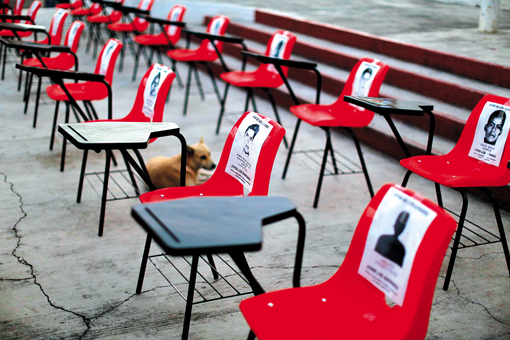The disappearance and apparent murder of 43 students in Iguala, Mexico, last September is a stark reminder of how organized crime and corruption are intertwined. The students were arrested by police officers allegedly sent by the mayor of Iguala, José Luis Abarca, to intercept their buses on their way to a demonstration. Reportedly, the students were then handed over to a local criminal cartel at the mayor’s instructions and later killed. Spurred by the public outcry that followed, Mexican Attorney General Jesús Murillo Karam issued arrest warrants for several former government officials, including Abarca and his acolytes. Abarca and his wife fled and were subsequently arrested in Mexico City. On November 7, the attorney general announced that the drug syndicate Guerreros Unidos was responsible for the killings.
Nothing in recent years illustrates more clearly the degree to which organized crime holds a grip on politics in Mexico. It came as no surprise that local politicians were collaborating with organized crime. However, the sheer brutality of the crimes perpetrated in Iguala has attracted public outcry on a scale rarely seen before. It has also cast doubt on the capacity of President Enrique Peña Nieto, and on his government’s capacity to tackle these problems.
Successive governments have launched campaigns to confront this and other forms of corruption, with little success. The history of failure, though, did not deter Peña Nieto, as a presidential candidate, from promising his own cocktail of anti-corruption initiatives. His proposals included constitutional amendments to empower the Instituto Federal de Acceso a la Información y Protección de Datos (Federal Institute for Access to Information and Data Protection—IFAI) by broadening its mandate; an independent, citizen-based body to take charge of monitoring government advertising and the use of public funds; and a new anti-corruption commission.
Two years into his term, Peña Nieto still has a lot of ground to cover to make these promises a reality. While the law to strengthen the IFAI has already been approved and implemented, the proposed Comisión Nacional Anticorrupción (National Anti-Corruption Commission) has yet to materialize. The establishment of such a commission is item 85 in the Pacto por México (Pact for Mexico), a series of 95 reform initiatives agreed to by the country’s three main political parties.
The Senate approved a bill mandating the creation of the National Anti-Corruption Commission in 2013. The commission would be autonomous under the Constitution, and would have preventive and investigative powers to pursue offenses by civil servants at the federal, state and municipal level. It would be allowed to issue administrative sanctions such as fines, suspensions and dismissal. Furthermore, the bill mandates that the Federal District and each of the country’s 31 states establish an analogous local anti-corruption unit.
The bill is stuck in the Chamber of Deputies. The two main parties in the Chamber—the center-right Partido Acción Nacional (National Action Party—PAN) and the ruling Partido Revolucionario Institucional (Institutional Revolutionary Party—PRI)—cannot seem to agree on which state institution should be entrusted with fighting corruption, and have proposed different initiatives. While pri representatives in the Chamber have advocated for dropping the commission and entrusting the fight against corruption to a Fiscalía Anticorrupción (Anti-Corruption Prosecutor’s Office), the pan is pushing an initiative that would create a Sistema Nacional Anticorrupción (National Anti-Corruption System). That system would consist mainly of a national council, in which all public institutions involved in fighting corruption would participate, and a citizens’ ethics committee that would set up observatories around the country, filing claims and proposing public policies for fighting corruption. On October 21, the leader of the PRI representative in the lower house, Manlio Fabio Beltrones, welcomed the PAN’s proposal and offered to work on it with Peña Nieto’s initiative.
Should the proposed commission ever see the light of day, a constituti-
onally independent organ with real teeth could make a major contribution to fighting crime. The original proposal points in the right direction: an independent body tasked with investigating acts of both private and public corruption—at all levels of government.
However, even if a commission should emerge, it would face a number of significant challenges. To prosecute crimes, the commission would have to lean on the judiciary, an institution that is notoriously weak. The capacity of prosecutors is limited, as is their independence. The level of collaboration between the judiciary and law enforcement agencies is woefully inadequate, and in many instances these institutions have been compromised by organized crime.
Passage of the bill also depends on a fragile and temporary balance in Congress. The current level of party cooperation could be further undermined by the legislative elections in July 2015, which will introduce a freshly elected lower house. It is unclear whether the Pact for Mexico will survive the 2015 elections, much less deliver on agreement number 85. As Mexico is learning after the recent tragedy, fighting crime and corruption is often easier done on paper than in reality.





